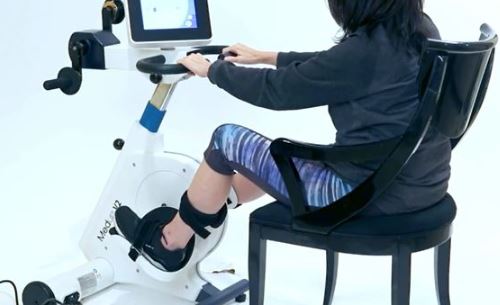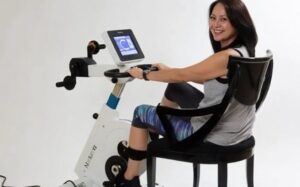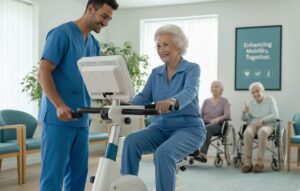
Physical activity and movement are an important part of a healthy lifestyle, and this fact doesn’t change for those experiencing health issues that might prevent it. When recovering from or maintaining disorders like Multiple Sclerosis, brain or spinal cord injuries, stroke and neurological or neuromuscular disorders like Alzheimer’s, cerebral palsy and Parkinson’s, movement can be key. However, many people who suffer from these ailments will struggle to get enough movement each day. This is where a passive cycle or ergometer comes in!
What is passive cycling?
Using an exercise bike is a common rehabilitation tool for a number of different issues and disorders. However, many patients are experiencing some level of muscle loss so will find themselves unable to perform the cycling movements on their own. In these cases, a passive cycle trainer or ergometer is the perfect option.
A passive cycle trainer is equipped with the ability to do all of the work for the user. If a person’s brain isn’t able to stimulate the necessary muscle contractions required to cycle or their muscles aren’t strong enough to push through the motion, a passive trainer is able to do the work for them. This results in muscles in the legs and arms being stretched and exercised, leading to a number of benefits.
The many benefits that can be realized with ergometer and cycling use are provided by the MedUp V2 Trainer. Health Canada approved, MedupBike.com is the exclusive distributor in Ontario. Available for purchase by institutions or private clients.
Many benefits of passive cycling
If a patient is unable to perform an exercise such as cycling on their own, there are a number of reasons to employ the use of an ergometer or passive cycling machine. Patients will often experience many of the same benefits as if they were doing the work themselves, while working within the confines of what their body is physically capable of. Over time, the patient may improve and find they are relying less on the passive setting and are able to incorporate more active effort.
Some top benefits of using a passive ergometer or cycle trainer include:
Reduced spasticity
Spasticity is an often-debilitating by-product of many physical disorders. Characterized by often painful stiffening and tightening muscle spams, spasticity can be a significant barrier in the day to day lives of those suffering from a variety of health conditions. Using a cycle trainer or ergometer can help stretch and strengthen muscles, even if the user isn’t able to perform the exercise on their own.
Improve blood flow without increasing heart rate
While increasing heart rate can have positive effects on cardiovascular health, putting too much strain on an injured heart can be harmful to some people. For this reason, using an ergometer or cycle trainer in the passive mode can provide the most benefit with the least potential negative effects.
Increase blood flow to legs and arms
The contraction and release of muscles helps force blood flow through the extremities. This can reduce affects like atrophy and the learned habit of not using injured limbs.
Increased range of motion and reduced stiffness
Stretching has been shown to increase range of motion and reduce muscle stiffness, which is also true in those dealing with neurological and muscular disorders.
Helps rebuild muscles
When muscles go unused for a length of time, whether by choice or inability to use them, they become weak very quickly. Rebuilding can take considerable effort and using a passive trainer can help when the body isn’t strong enough to complete the task on its own.
Improves insulin sensitivity
Exercise can help to treat and prevent diabetes by improving the body’s processing of insulin. The motor-driven pedals of a cycle trainer force leg and arm movement which can help moderate the rise of blood sugar after eating.
Built-in features promote safety
Although the idea of a patient using a passive ergometer or cycle trainer on their own might seem unwise, built-in safety features do help make it safe. Built-in spasm recognition software and a solid base that will not move when it is being used help patients to benefit from exercise, even when they are dealing with poor or no muscle control.

Rehabilitation & Improving Quality of Life
Incorporating a passive cycle routine into a recovery plan is a great way to build muscle and movement, even when the patient may struggle to do so on their own. Patients of a catastrophic accident or those dealing with a debilitating illness can will gain extraordinary joy and benefit from gaining mobility of their extremities, while improving their overall health. Look for equipment that may help patients gain function and financial support programs offered by government or other support programs.




